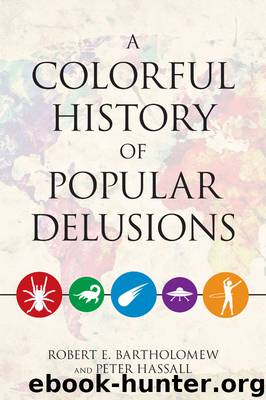A Colorful History of Popular Delusions by Robert E. Bartholomew

Author:Robert E. Bartholomew [Bartholomew, Robert E.]
Language: eng
Format: epub
ISBN: 9781633881235
Publisher: Prometheus Books
Published: 2015-09-16T04:00:00+00:00
Immediate community threats involve exaggerated feelings of danger within communities at-large, where members of the affected population are concerned over what is believed to be a personal threat. Episodes usually persist from a few weeks to several months and often recur periodically. Participants may express fear and concern, but rarely attempt to take flight. The underlying process of fantasy creation and spread is the fallibility of human perception, and the tendency for people sharing similar beliefs in group settings is to accept the opinion of the majority.
The mass media typically play a pivotal role in creating, maintaining, and eventually extinguishing episodes. At the beginning of outbreaks, they often exaggerate the perceived threat and report on it in an uncritical or sensational manner. These initial accounts may cause people to scrutinize their environment in an effort to confirm or deny the existence of the reported threat, giving rise to more sightings, and in turn, more media reports. During the American kissing-bug scare of 1899, people were warned to be on the lookout for the dreaded insect. While that year was no different than previous ones for the prevalence of the bug, people were looking out for kissing bugs and reported a spate of “attacks.” These had been from a variety of insects that had been mistaken for the kissing bug. No one ever saw the bug doing the dirty deed as they were said to attack while people were asleep. Once the media begins to turn critical and produce skeptical articles that often ridicule believers, the wave usually experiences a precipitous decline.
Occasionally the feared agent is a mysterious attacker believed to be terrorizing a community, such as the phantom slasher of Taipei, Taiwan. During a two-week period in 1956, nearly two dozen people claimed to have been slashed by a man welding a razor-blade-type object. Taiwanese police later determined the episode to have been imaginary. In the wake of rumors, lacerations caused by everything from incidental paper cuts or bumping into an umbrella on a crowded bus were redefined as slashings.1
Sometimes the imaginary threat is from an agent that is believed to cause illness, such as the series of phantom attacks in Mattoon, Illinois, during two weeks in 1944, that was believed to involve a “mad gasser.”2 On other occasions, the perceived agent of threat is more global and diffuse, such as the belief that poison gas from the tail of Halley's Comet posed a threat to all life on earth during its closest point of rendezvous in May 1910. The threat is often exaggerated by authority figures, such as the small number of scientists who expressed their opinion that the comet posed a danger.
Examining the social and cultural content of episodes is useful in understanding outbreaks. For instance, during the “ghost rocket” scare of 1946, authorities in Sweden were inundated with sightings of rockets that were believed to have been test-fired by Russia as a means to intimidate the country in the political uncertainty that followed the close of World War II.
Download
This site does not store any files on its server. We only index and link to content provided by other sites. Please contact the content providers to delete copyright contents if any and email us, we'll remove relevant links or contents immediately.
Rewire Your Anxious Brain by Catherine M. Pittman(18493)
Talking to Strangers by Malcolm Gladwell(13137)
The Art of Thinking Clearly by Rolf Dobelli(10144)
Mindhunter: Inside the FBI's Elite Serial Crime Unit by John E. Douglas & Mark Olshaker(9109)
Becoming Supernatural by Dr. Joe Dispenza(8042)
Change Your Questions, Change Your Life by Marilee Adams(7569)
The Road Less Traveled by M. Scott Peck(7477)
Nudge - Improving Decisions about Health, Wealth, and Happiness by Thaler Sunstein(7463)
The Lost Art of Listening by Michael P. Nichols(7362)
Mastermind: How to Think Like Sherlock Holmes by Maria Konnikova(7166)
Enlightenment Now: The Case for Reason, Science, Humanism, and Progress by Steven Pinker(7087)
Win Bigly by Scott Adams(7035)
The Way of Zen by Alan W. Watts(6454)
Daring Greatly by Brene Brown(6371)
Big Magic: Creative Living Beyond Fear by Elizabeth Gilbert(5559)
Grit by Angela Duckworth(5451)
Ego Is the Enemy by Ryan Holiday(5230)
Men In Love by Nancy Friday(5117)
Altered Sensations by David Pantalony(5009)
